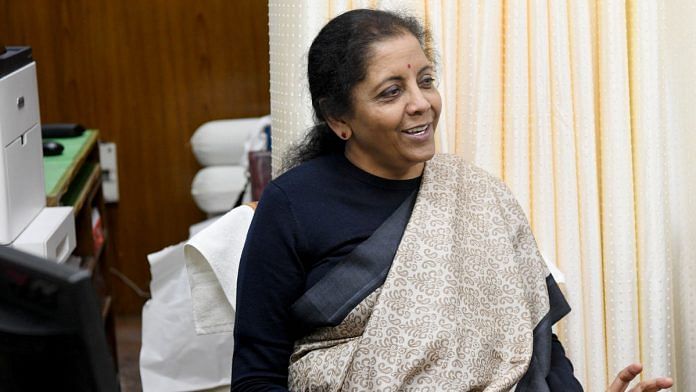The Union Budget is not merely an accounting and budgeting exercise for the central government. It is the time to make policy changes, financial sector regulatory reforms, tax policy reforms, and to set the tone for India’s openness to capital inflows.
Budget 2020 will be presented in an environment where Finance Minister Nirmala Sitharaman will be severely constrained by limited fiscal space.
First and foremost, the FM has to worry about the health of the economy. Key macroeconomic features of an economy are inflation, growth, investment, employment, and balance of payments. There is no balance of payments crisis, but on all other fronts, there is stress.
Sitharaman has to walk the tightrope of trying to expand demand without putting public debt on an unsustainable path. The fiscal deficit is already high, and if the growth rate falls below government borrowing rates, public debt can become unsustainable. Currently, the expected nominal GDP growth rate is likely to be 7.5 per cent. The ten-year bond yield is around 6.6 per cent. So, at present, public debt is at a sustainable level.
There is a significant amount of debate on whether Budget 2020 should be expansionary or not. While most people agree that there is a slippage in GDP growth and there are limits to what monetary policy can do, they are worried that a higher deficit may put Indian public debt on a path of unsustainable and explosive debt-to-GDP ratio. This is a legitimate concern.
A higher fiscal deficit has the risk of pushing up interest rates. If the interest rate rises above the GDP growth rate, then public debt expands faster than GDP, and the public debt/GDP ratio that defines the stability of public debt could start rising. At present, the pressure on interest rates is not high, because the private demand for borrowing is low. This could change if demand starts picking up.
Also read: It’ll be a tight-rope walk, but here’s what Sitharaman can do to boost investor confidence
Steps Sitharaman should take to increase demand
What steps should the FM take to raise demand? The simplest tools in the hands of policy-makers to raise demand are expansionary fiscal and monetary policies. But neither of these are ideal instruments at this time.
At 7.5 per cent, consumer price index inflation is significantly higher than the 4 per cent target. It is even higher than the wide 2 per cent band allowed around the target.
While it is most likely that this inflation, primarily caused by food inflation, and mostly led by vegetable price inflation, is transient, but it might encourage the Reserve Bank of India’s Monetary Policy Committee to continue to pause on monetary easing. Further, monetary policy transmission needs to be improved before we discuss further expansion.
Financial sector reforms that include banking and bond market reforms have been on the table for a while. The finance minister needs to bring about the legislative changes that are needed to move forward on these.
Fiscal space is limited due to the slowdown in GDP growth, shortfalls in tax collections, disinvestment difficulties, and the problems with GST. In a slowing economy, it would have been ideal to see an increase in government spending on public investment. But Sitharaman will have to find innovative ways of doing this, so that her fiscal deficit does not go up too much. She also needs to be transparent about government deficits and debt to win back credibility and the trust of the market. Only then can she borrow at sustainable rates.
The Comptroller and Auditor General has said that in previous years, borrowing was higher than the targets under the Fiscal Responsibility and Budget Management Act, maybe by as much as 2 percentage points of GDP. While the time to do fiscal expansion is when the economy is slowing, there is little point in having a discussion around numbers that people do not believe.
So, the finance minister’s first challenge is to present credible numbers, and then to convince people that she is committed to a path of fiscal prudence, even if she borrows beyond that.
Also read: 5.5% inflation is transitory, it shouldn’t prevent a fiscal boost in Budget 2020
Simplifying the tax regime
Can the FM take steps to push demand without a significant expansion in fiscal deficit? This may be the most challenging task ahead, but a beginning can be made by simplifying the tax and regulatory regime that has discouraged private investment. Some of the elements of increased power to tax administration that have pulled down investor sentiment can be revisited.
It is important that no further tax rate increases should be proposed, as these increase uncertainty, erode the tax base, and pull down growth. The strategy of improving tax collections by increasing tax rates and the power of tax officials for search and seizure has not paid off in terms of higher tax revenue. This strategy has pulled down investor confidence and GDP.
It is time to adopt the alternative strategy of lower rates and less raiding powers to tax officers, along with data analytics, to support a less intrusive and more rational tax policy.
Also read: The 4 priorities for Nirmala Sitharaman in Budget 2020
The author is an economist and a professor at the National Institute of Public Finance and Policy. Views are personal.




In simple English, there is not much the lady can do, except make the best of a dreadful situation. Do no harm. Be honest.